Diploma in Strategic Management Assignment PDF
VerifiedAdded on 2021/01/21
|12
|4333
|1195
AI Summary
Contribute Materials
Your contribution can guide someone’s learning journey. Share your
documents today.
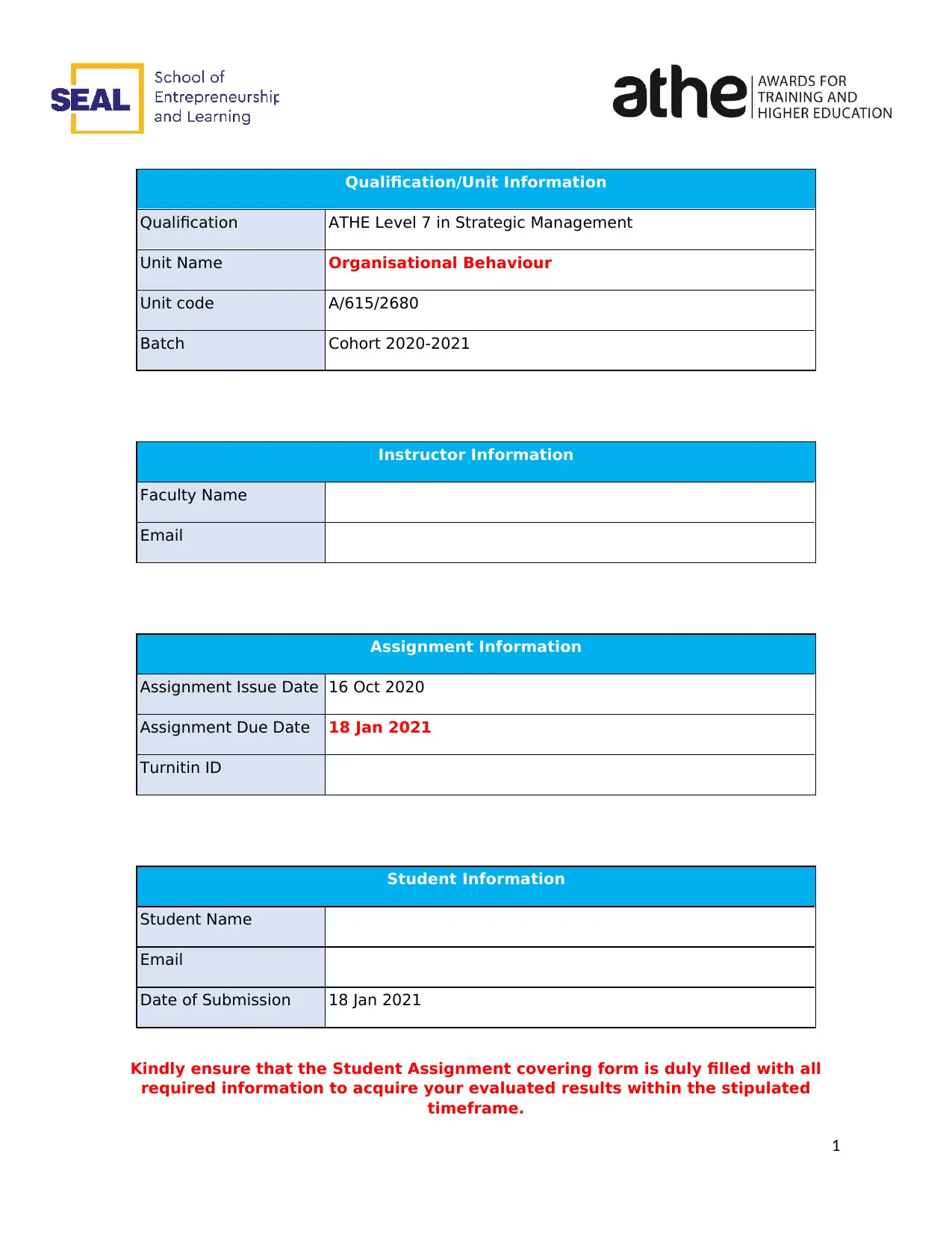
Qualification/Unit Information
Qualification ATHE Level 7 in Strategic Management
Unit Name Organisational Behaviour
Unit code A/615/2680
Batch Cohort 2020-2021
Instructor Information
Faculty Name
Email
Assignment Information
Assignment Issue Date 16 Oct 2020
Assignment Due Date 18 Jan 2021
Turnitin ID
Student Information
Student Name
Email
Date of Submission 18 Jan 2021
Kindly ensure that the Student Assignment covering form is duly filled with all
required information to acquire your evaluated results within the stipulated
timeframe.
1
Qualification ATHE Level 7 in Strategic Management
Unit Name Organisational Behaviour
Unit code A/615/2680
Batch Cohort 2020-2021
Instructor Information
Faculty Name
Assignment Information
Assignment Issue Date 16 Oct 2020
Assignment Due Date 18 Jan 2021
Turnitin ID
Student Information
Student Name
Date of Submission 18 Jan 2021
Kindly ensure that the Student Assignment covering form is duly filled with all
required information to acquire your evaluated results within the stipulated
timeframe.
1
Secure Best Marks with AI Grader
Need help grading? Try our AI Grader for instant feedback on your assignments.
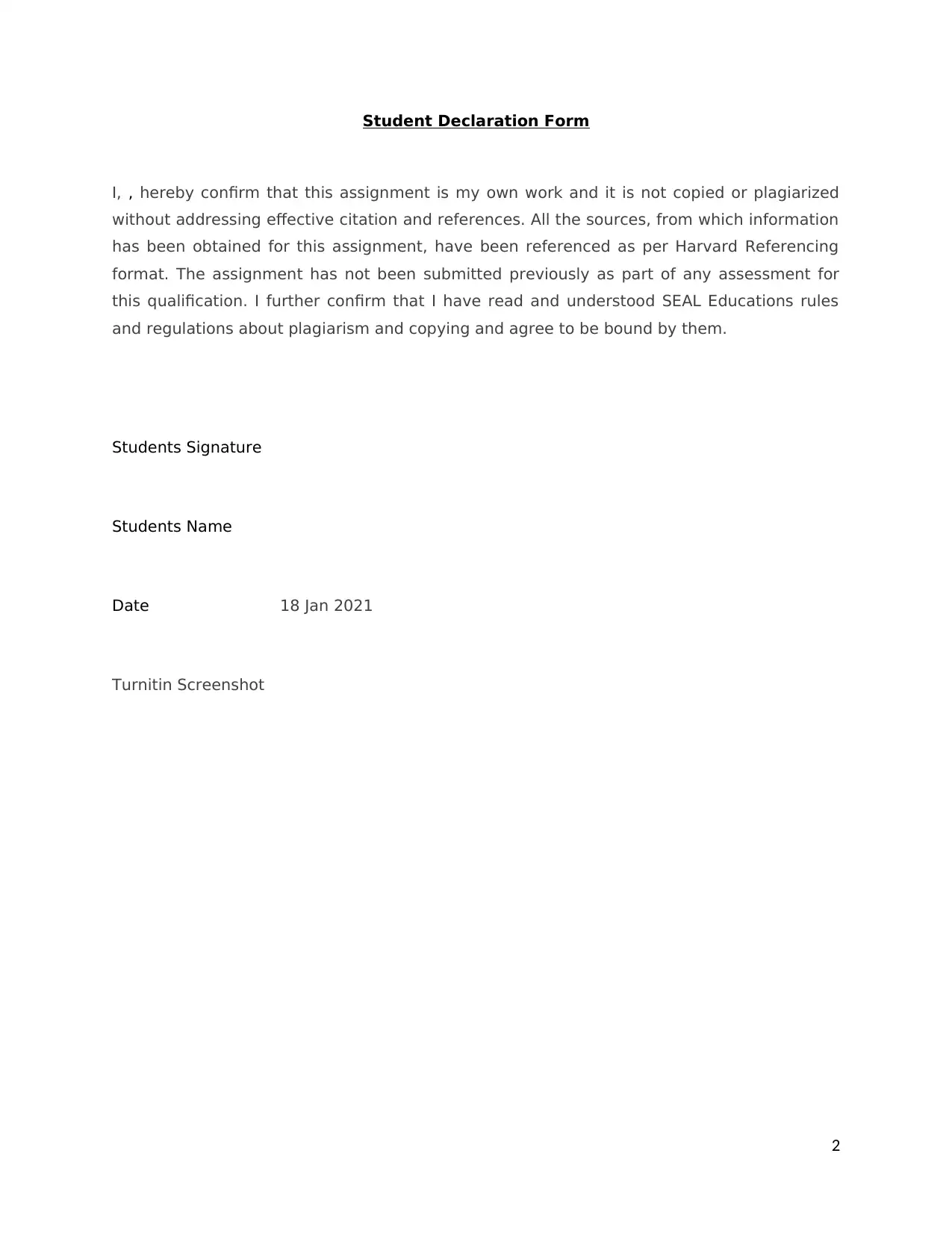
Student Declaration Form
I, , hereby confirm that this assignment is my own work and it is not copied or plagiarized
without addressing effective citation and references. All the sources, from which information
has been obtained for this assignment, have been referenced as per Harvard Referencing
format. The assignment has not been submitted previously as part of any assessment for
this qualification. I further confirm that I have read and understood SEAL Educations rules
and regulations about plagiarism and copying and agree to be bound by them.
Students Signature
Students Name
Date 18 Jan 2021
Turnitin Screenshot
2
I, , hereby confirm that this assignment is my own work and it is not copied or plagiarized
without addressing effective citation and references. All the sources, from which information
has been obtained for this assignment, have been referenced as per Harvard Referencing
format. The assignment has not been submitted previously as part of any assessment for
this qualification. I further confirm that I have read and understood SEAL Educations rules
and regulations about plagiarism and copying and agree to be bound by them.
Students Signature
Students Name
Date 18 Jan 2021
Turnitin Screenshot
2
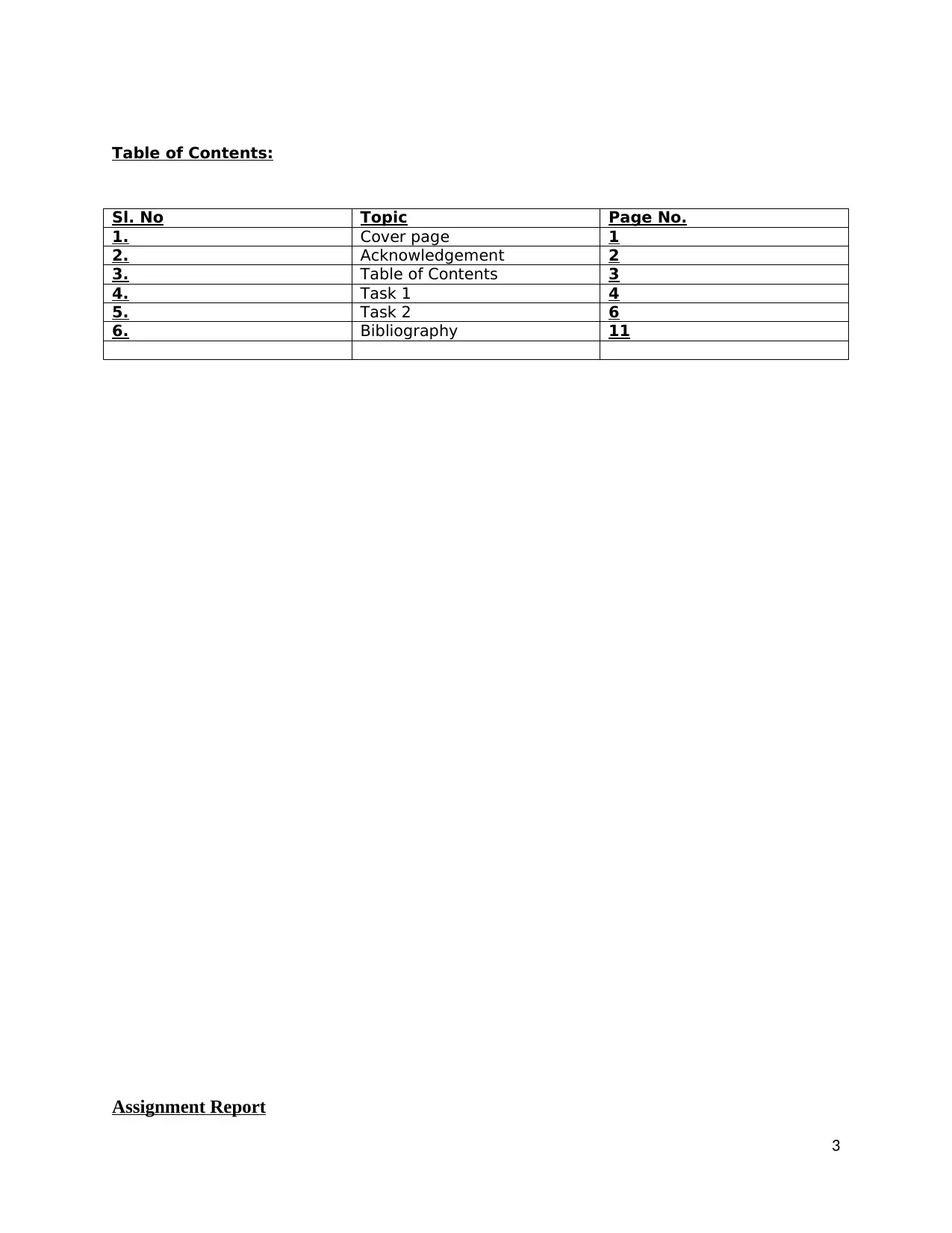
Table of Contents:
Sl. No Topic Page No.
1. Cover page 1
2. Acknowledgement 2
3. Table of Contents 3
4. Task 1 4
5. Task 2 6
6. Bibliography 11
Assignment Report
3
Sl. No Topic Page No.
1. Cover page 1
2. Acknowledgement 2
3. Table of Contents 3
4. Task 1 4
5. Task 2 6
6. Bibliography 11
Assignment Report
3

1.1 Analysis of different organizational structures
Different organizations have various structures based on their aims and culture. Any
organization’s framework will be the determinant of the way the tasks and performances are
performed. Organizational structures allow the duties that are required to be clearly delegated to
various personnel and departments for different processes and functions.
1.1.1 Simple structure
There are fewer layers of management between the executive level and the front-line staff in a
simple organizational structure. The basis behind the simple organizational structure will be to
motivate workers by turning them into a greater part of the decision-making process. This style
of organizational structure indicates improved contact between top leaders and workers, a good
working spirit, less bureaucracy, faster decision making, and less layers of management. Toyota
is an organizational example of a simple structure that has embraced and generated profits from
this approach. Toyota gave up micromanaging the workers entirely (Galbraith, J.R., 2014).
1.1.2 Functional structure
A functional structure contains several levels of management and supervision. A long chain of
command runs from the top of the organization to the bottom of it. The control period is narrow,
with a clearer management structure in each layer with a clearer and separate feature. Coca Cola
has a functional organizational structure; it is managed by a vertical hierarchy in which upper-
level decision-making is made, while medium-level line managers make decisions relevant to
daily operations.
The organization’s functional structure consists of different levels of hierarchy with several
executives playing the roles of overseeing and handling employees and staff. It’s kind of
complicated, so it takes more time to respond to the modifications. Under this organizational
framework, the different levels of management create certain guidelines, regulations and laws
that are important for the lower level employees to obey. Although the decisions taken take a lot
of time, the contact process is handled very quickly. The cost of conducting business operations
is higher due to the presence of multiple managers and supervisors, and because of this, it
introduces some complications as a result.
1.1.3 Hierarchical structure
Control and responsibility must be explicitly quantified and assigned to individuals within the
organization’s hierarchical structure in accordance with their rank and position within the
hierarchy. A collection of separate functional structures that report to a central core is a
multidivisional structure. Every functional framework is accountable for the operation of daily
activities. Supervision and management of the organizations relation with environment and
strategy are the responsibility of the central workers.
1.2 Influence of organizational culture on organizational effectiveness
4
Different organizations have various structures based on their aims and culture. Any
organization’s framework will be the determinant of the way the tasks and performances are
performed. Organizational structures allow the duties that are required to be clearly delegated to
various personnel and departments for different processes and functions.
1.1.1 Simple structure
There are fewer layers of management between the executive level and the front-line staff in a
simple organizational structure. The basis behind the simple organizational structure will be to
motivate workers by turning them into a greater part of the decision-making process. This style
of organizational structure indicates improved contact between top leaders and workers, a good
working spirit, less bureaucracy, faster decision making, and less layers of management. Toyota
is an organizational example of a simple structure that has embraced and generated profits from
this approach. Toyota gave up micromanaging the workers entirely (Galbraith, J.R., 2014).
1.1.2 Functional structure
A functional structure contains several levels of management and supervision. A long chain of
command runs from the top of the organization to the bottom of it. The control period is narrow,
with a clearer management structure in each layer with a clearer and separate feature. Coca Cola
has a functional organizational structure; it is managed by a vertical hierarchy in which upper-
level decision-making is made, while medium-level line managers make decisions relevant to
daily operations.
The organization’s functional structure consists of different levels of hierarchy with several
executives playing the roles of overseeing and handling employees and staff. It’s kind of
complicated, so it takes more time to respond to the modifications. Under this organizational
framework, the different levels of management create certain guidelines, regulations and laws
that are important for the lower level employees to obey. Although the decisions taken take a lot
of time, the contact process is handled very quickly. The cost of conducting business operations
is higher due to the presence of multiple managers and supervisors, and because of this, it
introduces some complications as a result.
1.1.3 Hierarchical structure
Control and responsibility must be explicitly quantified and assigned to individuals within the
organization’s hierarchical structure in accordance with their rank and position within the
hierarchy. A collection of separate functional structures that report to a central core is a
multidivisional structure. Every functional framework is accountable for the operation of daily
activities. Supervision and management of the organizations relation with environment and
strategy are the responsibility of the central workers.
1.2 Influence of organizational culture on organizational effectiveness
4
Secure Best Marks with AI Grader
Need help grading? Try our AI Grader for instant feedback on your assignments.
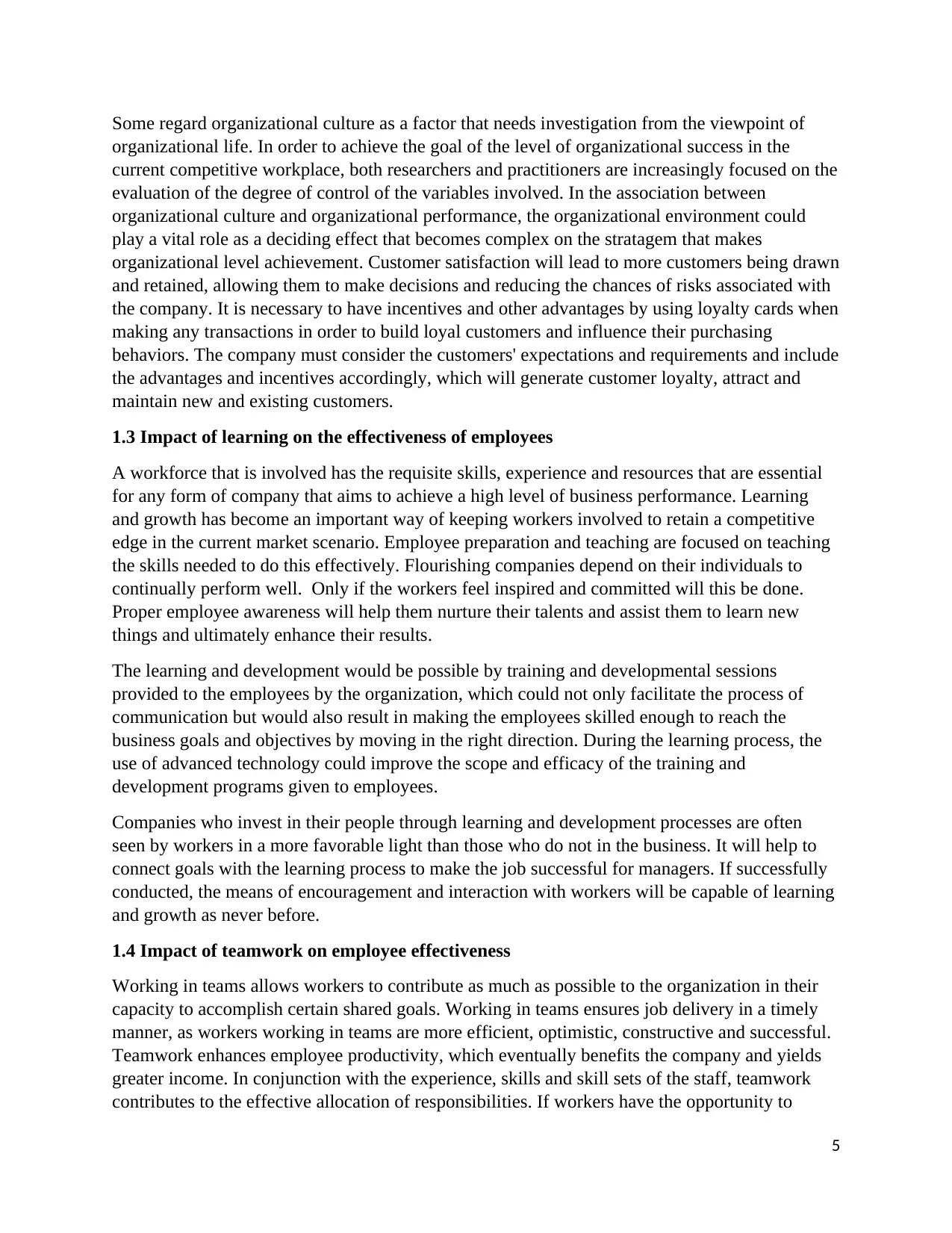
Some regard organizational culture as a factor that needs investigation from the viewpoint of
organizational life. In order to achieve the goal of the level of organizational success in the
current competitive workplace, both researchers and practitioners are increasingly focused on the
evaluation of the degree of control of the variables involved. In the association between
organizational culture and organizational performance, the organizational environment could
play a vital role as a deciding effect that becomes complex on the stratagem that makes
organizational level achievement. Customer satisfaction will lead to more customers being drawn
and retained, allowing them to make decisions and reducing the chances of risks associated with
the company. It is necessary to have incentives and other advantages by using loyalty cards when
making any transactions in order to build loyal customers and influence their purchasing
behaviors. The company must consider the customers' expectations and requirements and include
the advantages and incentives accordingly, which will generate customer loyalty, attract and
maintain new and existing customers.
1.3 Impact of learning on the effectiveness of employees
A workforce that is involved has the requisite skills, experience and resources that are essential
for any form of company that aims to achieve a high level of business performance. Learning
and growth has become an important way of keeping workers involved to retain a competitive
edge in the current market scenario. Employee preparation and teaching are focused on teaching
the skills needed to do this effectively. Flourishing companies depend on their individuals to
continually perform well. Only if the workers feel inspired and committed will this be done.
Proper employee awareness will help them nurture their talents and assist them to learn new
things and ultimately enhance their results.
The learning and development would be possible by training and developmental sessions
provided to the employees by the organization, which could not only facilitate the process of
communication but would also result in making the employees skilled enough to reach the
business goals and objectives by moving in the right direction. During the learning process, the
use of advanced technology could improve the scope and efficacy of the training and
development programs given to employees.
Companies who invest in their people through learning and development processes are often
seen by workers in a more favorable light than those who do not in the business. It will help to
connect goals with the learning process to make the job successful for managers. If successfully
conducted, the means of encouragement and interaction with workers will be capable of learning
and growth as never before.
1.4 Impact of teamwork on employee effectiveness
Working in teams allows workers to contribute as much as possible to the organization in their
capacity to accomplish certain shared goals. Working in teams ensures job delivery in a timely
manner, as workers working in teams are more efficient, optimistic, constructive and successful.
Teamwork enhances employee productivity, which eventually benefits the company and yields
greater income. In conjunction with the experience, skills and skill sets of the staff, teamwork
contributes to the effective allocation of responsibilities. If workers have the opportunity to
5
organizational life. In order to achieve the goal of the level of organizational success in the
current competitive workplace, both researchers and practitioners are increasingly focused on the
evaluation of the degree of control of the variables involved. In the association between
organizational culture and organizational performance, the organizational environment could
play a vital role as a deciding effect that becomes complex on the stratagem that makes
organizational level achievement. Customer satisfaction will lead to more customers being drawn
and retained, allowing them to make decisions and reducing the chances of risks associated with
the company. It is necessary to have incentives and other advantages by using loyalty cards when
making any transactions in order to build loyal customers and influence their purchasing
behaviors. The company must consider the customers' expectations and requirements and include
the advantages and incentives accordingly, which will generate customer loyalty, attract and
maintain new and existing customers.
1.3 Impact of learning on the effectiveness of employees
A workforce that is involved has the requisite skills, experience and resources that are essential
for any form of company that aims to achieve a high level of business performance. Learning
and growth has become an important way of keeping workers involved to retain a competitive
edge in the current market scenario. Employee preparation and teaching are focused on teaching
the skills needed to do this effectively. Flourishing companies depend on their individuals to
continually perform well. Only if the workers feel inspired and committed will this be done.
Proper employee awareness will help them nurture their talents and assist them to learn new
things and ultimately enhance their results.
The learning and development would be possible by training and developmental sessions
provided to the employees by the organization, which could not only facilitate the process of
communication but would also result in making the employees skilled enough to reach the
business goals and objectives by moving in the right direction. During the learning process, the
use of advanced technology could improve the scope and efficacy of the training and
development programs given to employees.
Companies who invest in their people through learning and development processes are often
seen by workers in a more favorable light than those who do not in the business. It will help to
connect goals with the learning process to make the job successful for managers. If successfully
conducted, the means of encouragement and interaction with workers will be capable of learning
and growth as never before.
1.4 Impact of teamwork on employee effectiveness
Working in teams allows workers to contribute as much as possible to the organization in their
capacity to accomplish certain shared goals. Working in teams ensures job delivery in a timely
manner, as workers working in teams are more efficient, optimistic, constructive and successful.
Teamwork enhances employee productivity, which eventually benefits the company and yields
greater income. In conjunction with the experience, skills and skill sets of the staff, teamwork
contributes to the effective allocation of responsibilities. If workers have the opportunity to
5
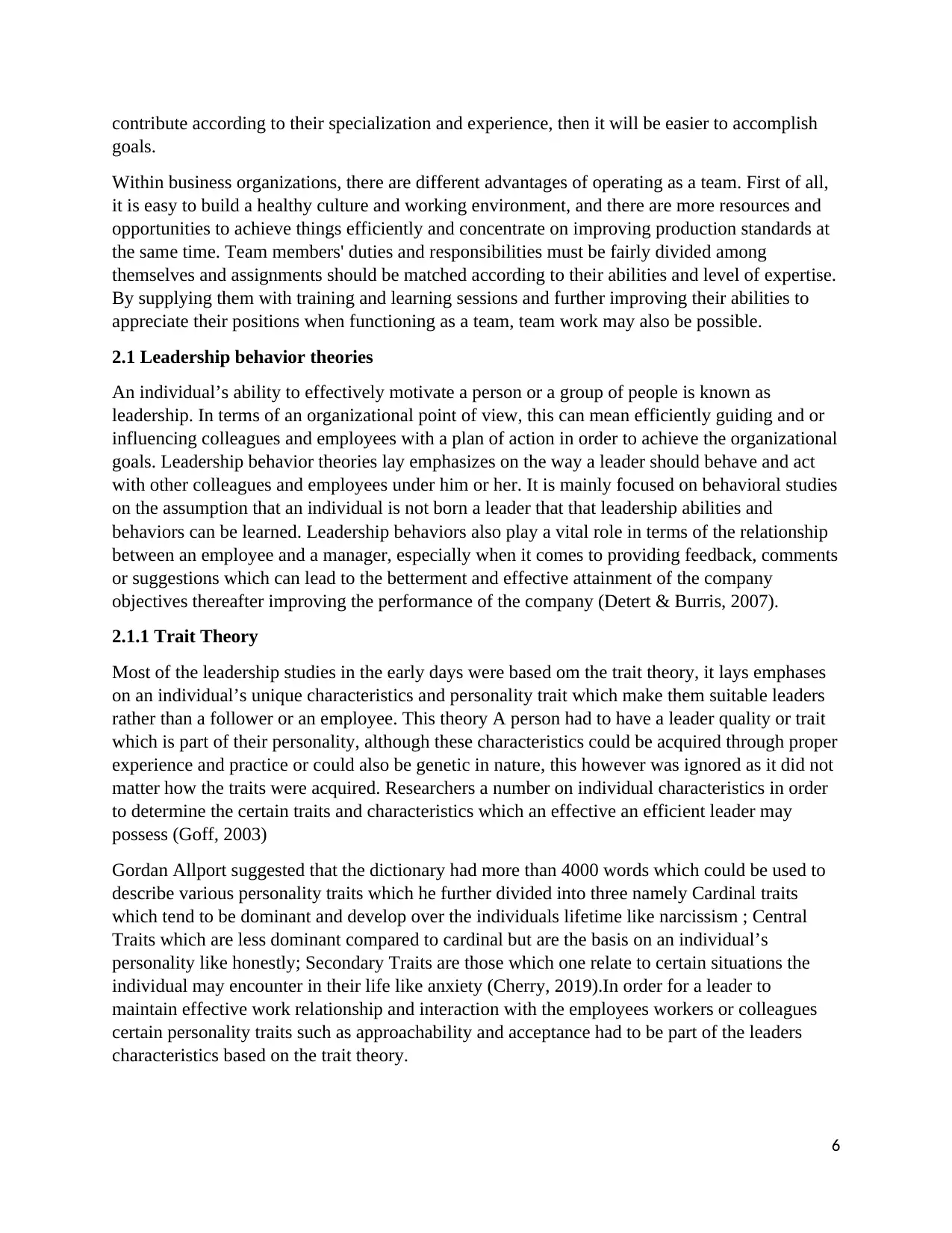
contribute according to their specialization and experience, then it will be easier to accomplish
goals.
Within business organizations, there are different advantages of operating as a team. First of all,
it is easy to build a healthy culture and working environment, and there are more resources and
opportunities to achieve things efficiently and concentrate on improving production standards at
the same time. Team members' duties and responsibilities must be fairly divided among
themselves and assignments should be matched according to their abilities and level of expertise.
By supplying them with training and learning sessions and further improving their abilities to
appreciate their positions when functioning as a team, team work may also be possible.
2.1 Leadership behavior theories
An individual’s ability to effectively motivate a person or a group of people is known as
leadership. In terms of an organizational point of view, this can mean efficiently guiding and or
influencing colleagues and employees with a plan of action in order to achieve the organizational
goals. Leadership behavior theories lay emphasizes on the way a leader should behave and act
with other colleagues and employees under him or her. It is mainly focused on behavioral studies
on the assumption that an individual is not born a leader that that leadership abilities and
behaviors can be learned. Leadership behaviors also play a vital role in terms of the relationship
between an employee and a manager, especially when it comes to providing feedback, comments
or suggestions which can lead to the betterment and effective attainment of the company
objectives thereafter improving the performance of the company (Detert & Burris, 2007).
2.1.1 Trait Theory
Most of the leadership studies in the early days were based om the trait theory, it lays emphases
on an individual’s unique characteristics and personality trait which make them suitable leaders
rather than a follower or an employee. This theory A person had to have a leader quality or trait
which is part of their personality, although these characteristics could be acquired through proper
experience and practice or could also be genetic in nature, this however was ignored as it did not
matter how the traits were acquired. Researchers a number on individual characteristics in order
to determine the certain traits and characteristics which an effective an efficient leader may
possess (Goff, 2003)
Gordan Allport suggested that the dictionary had more than 4000 words which could be used to
describe various personality traits which he further divided into three namely Cardinal traits
which tend to be dominant and develop over the individuals lifetime like narcissism ; Central
Traits which are less dominant compared to cardinal but are the basis on an individual’s
personality like honestly; Secondary Traits are those which one relate to certain situations the
individual may encounter in their life like anxiety (Cherry, 2019).In order for a leader to
maintain effective work relationship and interaction with the employees workers or colleagues
certain personality traits such as approachability and acceptance had to be part of the leaders
characteristics based on the trait theory.
6
goals.
Within business organizations, there are different advantages of operating as a team. First of all,
it is easy to build a healthy culture and working environment, and there are more resources and
opportunities to achieve things efficiently and concentrate on improving production standards at
the same time. Team members' duties and responsibilities must be fairly divided among
themselves and assignments should be matched according to their abilities and level of expertise.
By supplying them with training and learning sessions and further improving their abilities to
appreciate their positions when functioning as a team, team work may also be possible.
2.1 Leadership behavior theories
An individual’s ability to effectively motivate a person or a group of people is known as
leadership. In terms of an organizational point of view, this can mean efficiently guiding and or
influencing colleagues and employees with a plan of action in order to achieve the organizational
goals. Leadership behavior theories lay emphasizes on the way a leader should behave and act
with other colleagues and employees under him or her. It is mainly focused on behavioral studies
on the assumption that an individual is not born a leader that that leadership abilities and
behaviors can be learned. Leadership behaviors also play a vital role in terms of the relationship
between an employee and a manager, especially when it comes to providing feedback, comments
or suggestions which can lead to the betterment and effective attainment of the company
objectives thereafter improving the performance of the company (Detert & Burris, 2007).
2.1.1 Trait Theory
Most of the leadership studies in the early days were based om the trait theory, it lays emphases
on an individual’s unique characteristics and personality trait which make them suitable leaders
rather than a follower or an employee. This theory A person had to have a leader quality or trait
which is part of their personality, although these characteristics could be acquired through proper
experience and practice or could also be genetic in nature, this however was ignored as it did not
matter how the traits were acquired. Researchers a number on individual characteristics in order
to determine the certain traits and characteristics which an effective an efficient leader may
possess (Goff, 2003)
Gordan Allport suggested that the dictionary had more than 4000 words which could be used to
describe various personality traits which he further divided into three namely Cardinal traits
which tend to be dominant and develop over the individuals lifetime like narcissism ; Central
Traits which are less dominant compared to cardinal but are the basis on an individual’s
personality like honestly; Secondary Traits are those which one relate to certain situations the
individual may encounter in their life like anxiety (Cherry, 2019).In order for a leader to
maintain effective work relationship and interaction with the employees workers or colleagues
certain personality traits such as approachability and acceptance had to be part of the leaders
characteristics based on the trait theory.
6
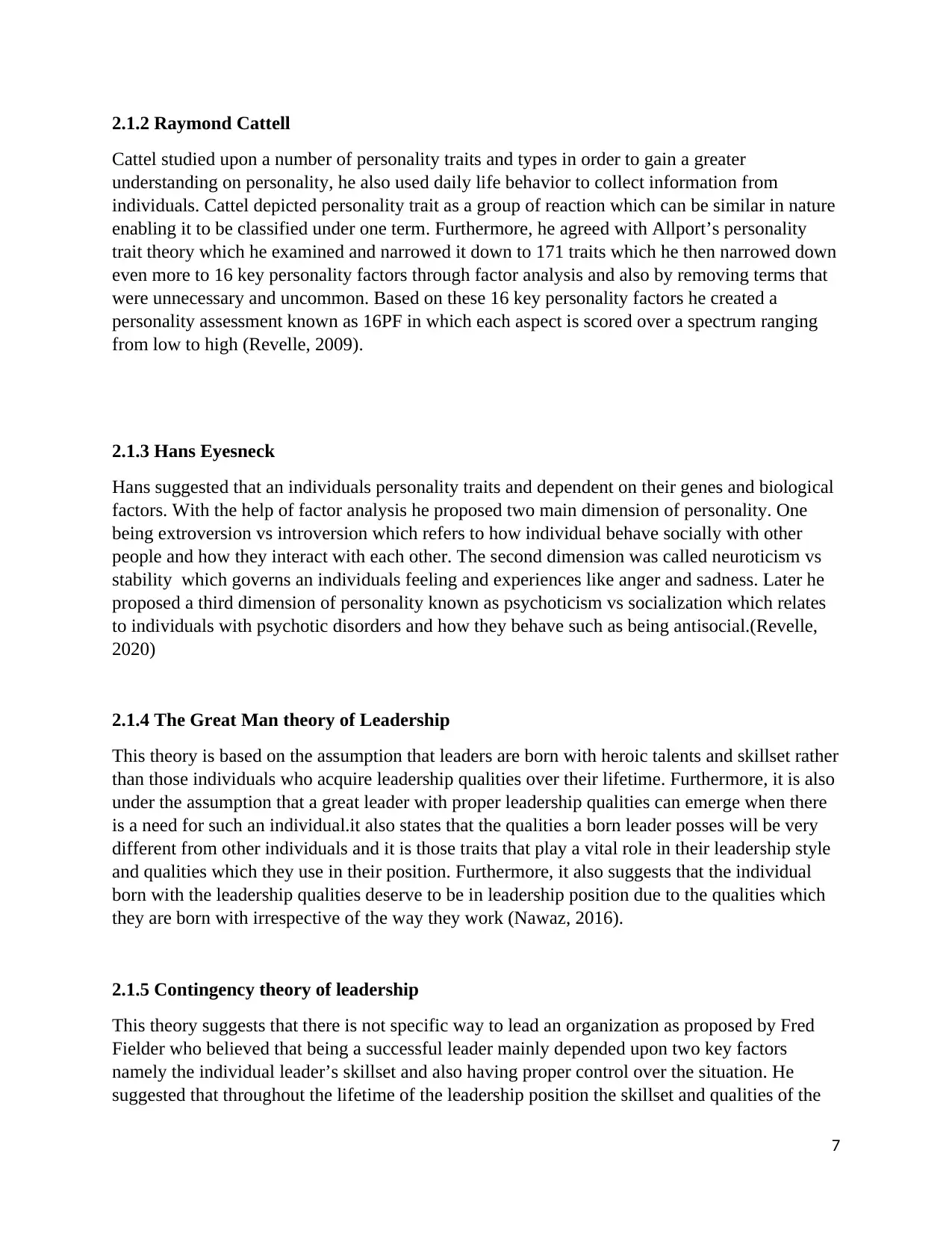
2.1.2 Raymond Cattell
Cattel studied upon a number of personality traits and types in order to gain a greater
understanding on personality, he also used daily life behavior to collect information from
individuals. Cattel depicted personality trait as a group of reaction which can be similar in nature
enabling it to be classified under one term. Furthermore, he agreed with Allport’s personality
trait theory which he examined and narrowed it down to 171 traits which he then narrowed down
even more to 16 key personality factors through factor analysis and also by removing terms that
were unnecessary and uncommon. Based on these 16 key personality factors he created a
personality assessment known as 16PF in which each aspect is scored over a spectrum ranging
from low to high (Revelle, 2009).
2.1.3 Hans Eyesneck
Hans suggested that an individuals personality traits and dependent on their genes and biological
factors. With the help of factor analysis he proposed two main dimension of personality. One
being extroversion vs introversion which refers to how individual behave socially with other
people and how they interact with each other. The second dimension was called neuroticism vs
stability which governs an individuals feeling and experiences like anger and sadness. Later he
proposed a third dimension of personality known as psychoticism vs socialization which relates
to individuals with psychotic disorders and how they behave such as being antisocial.(Revelle,
2020)
2.1.4 The Great Man theory of Leadership
This theory is based on the assumption that leaders are born with heroic talents and skillset rather
than those individuals who acquire leadership qualities over their lifetime. Furthermore, it is also
under the assumption that a great leader with proper leadership qualities can emerge when there
is a need for such an individual.it also states that the qualities a born leader posses will be very
different from other individuals and it is those traits that play a vital role in their leadership style
and qualities which they use in their position. Furthermore, it also suggests that the individual
born with the leadership qualities deserve to be in leadership position due to the qualities which
they are born with irrespective of the way they work (Nawaz, 2016).
2.1.5 Contingency theory of leadership
This theory suggests that there is not specific way to lead an organization as proposed by Fred
Fielder who believed that being a successful leader mainly depended upon two key factors
namely the individual leader’s skillset and also having proper control over the situation. He
suggested that throughout the lifetime of the leadership position the skillset and qualities of the
7
Cattel studied upon a number of personality traits and types in order to gain a greater
understanding on personality, he also used daily life behavior to collect information from
individuals. Cattel depicted personality trait as a group of reaction which can be similar in nature
enabling it to be classified under one term. Furthermore, he agreed with Allport’s personality
trait theory which he examined and narrowed it down to 171 traits which he then narrowed down
even more to 16 key personality factors through factor analysis and also by removing terms that
were unnecessary and uncommon. Based on these 16 key personality factors he created a
personality assessment known as 16PF in which each aspect is scored over a spectrum ranging
from low to high (Revelle, 2009).
2.1.3 Hans Eyesneck
Hans suggested that an individuals personality traits and dependent on their genes and biological
factors. With the help of factor analysis he proposed two main dimension of personality. One
being extroversion vs introversion which refers to how individual behave socially with other
people and how they interact with each other. The second dimension was called neuroticism vs
stability which governs an individuals feeling and experiences like anger and sadness. Later he
proposed a third dimension of personality known as psychoticism vs socialization which relates
to individuals with psychotic disorders and how they behave such as being antisocial.(Revelle,
2020)
2.1.4 The Great Man theory of Leadership
This theory is based on the assumption that leaders are born with heroic talents and skillset rather
than those individuals who acquire leadership qualities over their lifetime. Furthermore, it is also
under the assumption that a great leader with proper leadership qualities can emerge when there
is a need for such an individual.it also states that the qualities a born leader posses will be very
different from other individuals and it is those traits that play a vital role in their leadership style
and qualities which they use in their position. Furthermore, it also suggests that the individual
born with the leadership qualities deserve to be in leadership position due to the qualities which
they are born with irrespective of the way they work (Nawaz, 2016).
2.1.5 Contingency theory of leadership
This theory suggests that there is not specific way to lead an organization as proposed by Fred
Fielder who believed that being a successful leader mainly depended upon two key factors
namely the individual leader’s skillset and also having proper control over the situation. He
suggested that throughout the lifetime of the leadership position the skillset and qualities of the
7
Paraphrase This Document
Need a fresh take? Get an instant paraphrase of this document with our AI Paraphraser
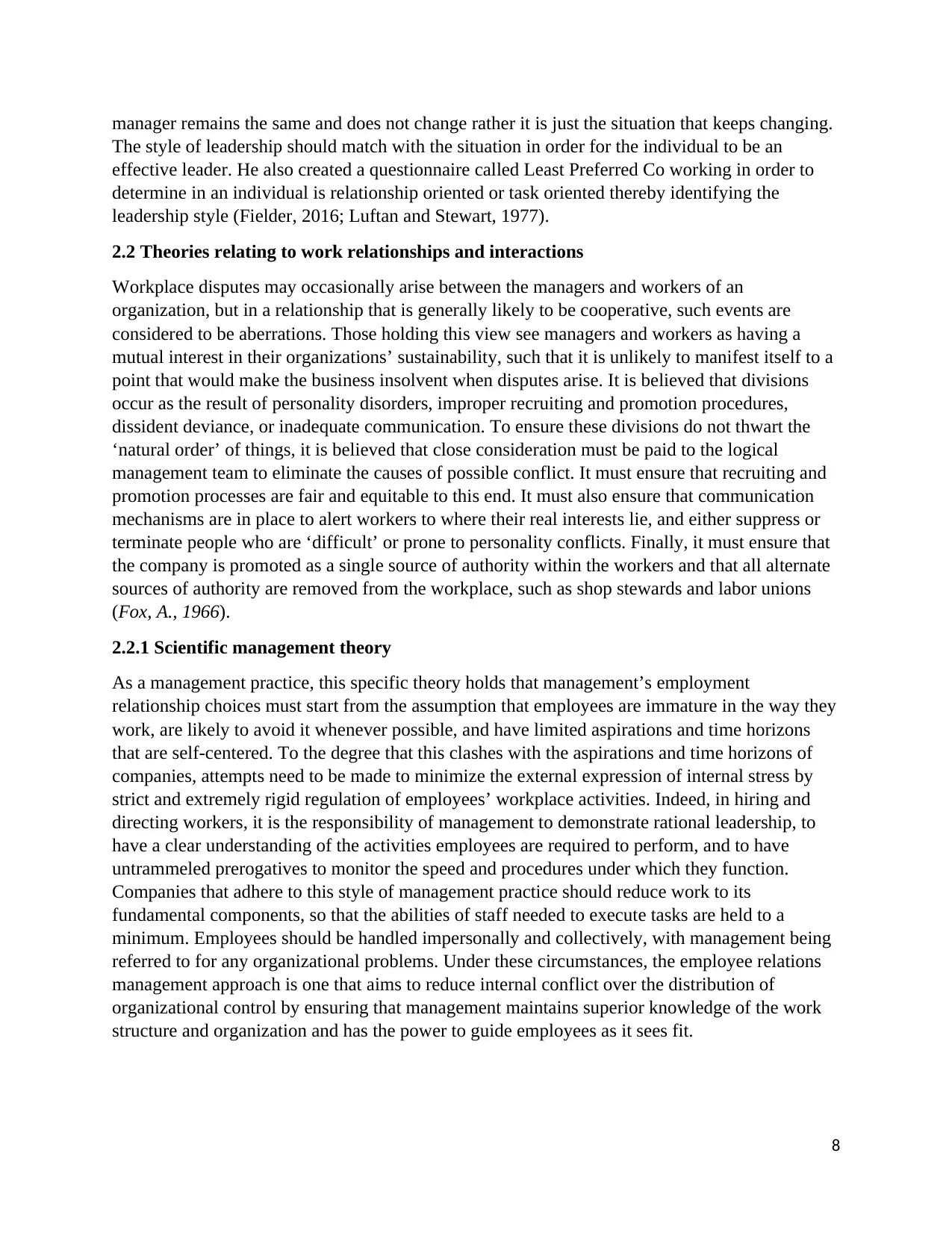
manager remains the same and does not change rather it is just the situation that keeps changing.
The style of leadership should match with the situation in order for the individual to be an
effective leader. He also created a questionnaire called Least Preferred Co working in order to
determine in an individual is relationship oriented or task oriented thereby identifying the
leadership style (Fielder, 2016; Luftan and Stewart, 1977).
2.2 Theories relating to work relationships and interactions
Workplace disputes may occasionally arise between the managers and workers of an
organization, but in a relationship that is generally likely to be cooperative, such events are
considered to be aberrations. Those holding this view see managers and workers as having a
mutual interest in their organizations’ sustainability, such that it is unlikely to manifest itself to a
point that would make the business insolvent when disputes arise. It is believed that divisions
occur as the result of personality disorders, improper recruiting and promotion procedures,
dissident deviance, or inadequate communication. To ensure these divisions do not thwart the
‘natural order’ of things, it is believed that close consideration must be paid to the logical
management team to eliminate the causes of possible conflict. It must ensure that recruiting and
promotion processes are fair and equitable to this end. It must also ensure that communication
mechanisms are in place to alert workers to where their real interests lie, and either suppress or
terminate people who are ‘difficult’ or prone to personality conflicts. Finally, it must ensure that
the company is promoted as a single source of authority within the workers and that all alternate
sources of authority are removed from the workplace, such as shop stewards and labor unions
(Fox, A., 1966).
2.2.1 Scientific management theory
As a management practice, this specific theory holds that management’s employment
relationship choices must start from the assumption that employees are immature in the way they
work, are likely to avoid it whenever possible, and have limited aspirations and time horizons
that are self-centered. To the degree that this clashes with the aspirations and time horizons of
companies, attempts need to be made to minimize the external expression of internal stress by
strict and extremely rigid regulation of employees’ workplace activities. Indeed, in hiring and
directing workers, it is the responsibility of management to demonstrate rational leadership, to
have a clear understanding of the activities employees are required to perform, and to have
untrammeled prerogatives to monitor the speed and procedures under which they function.
Companies that adhere to this style of management practice should reduce work to its
fundamental components, so that the abilities of staff needed to execute tasks are held to a
minimum. Employees should be handled impersonally and collectively, with management being
referred to for any organizational problems. Under these circumstances, the employee relations
management approach is one that aims to reduce internal conflict over the distribution of
organizational control by ensuring that management maintains superior knowledge of the work
structure and organization and has the power to guide employees as it sees fit.
8
The style of leadership should match with the situation in order for the individual to be an
effective leader. He also created a questionnaire called Least Preferred Co working in order to
determine in an individual is relationship oriented or task oriented thereby identifying the
leadership style (Fielder, 2016; Luftan and Stewart, 1977).
2.2 Theories relating to work relationships and interactions
Workplace disputes may occasionally arise between the managers and workers of an
organization, but in a relationship that is generally likely to be cooperative, such events are
considered to be aberrations. Those holding this view see managers and workers as having a
mutual interest in their organizations’ sustainability, such that it is unlikely to manifest itself to a
point that would make the business insolvent when disputes arise. It is believed that divisions
occur as the result of personality disorders, improper recruiting and promotion procedures,
dissident deviance, or inadequate communication. To ensure these divisions do not thwart the
‘natural order’ of things, it is believed that close consideration must be paid to the logical
management team to eliminate the causes of possible conflict. It must ensure that recruiting and
promotion processes are fair and equitable to this end. It must also ensure that communication
mechanisms are in place to alert workers to where their real interests lie, and either suppress or
terminate people who are ‘difficult’ or prone to personality conflicts. Finally, it must ensure that
the company is promoted as a single source of authority within the workers and that all alternate
sources of authority are removed from the workplace, such as shop stewards and labor unions
(Fox, A., 1966).
2.2.1 Scientific management theory
As a management practice, this specific theory holds that management’s employment
relationship choices must start from the assumption that employees are immature in the way they
work, are likely to avoid it whenever possible, and have limited aspirations and time horizons
that are self-centered. To the degree that this clashes with the aspirations and time horizons of
companies, attempts need to be made to minimize the external expression of internal stress by
strict and extremely rigid regulation of employees’ workplace activities. Indeed, in hiring and
directing workers, it is the responsibility of management to demonstrate rational leadership, to
have a clear understanding of the activities employees are required to perform, and to have
untrammeled prerogatives to monitor the speed and procedures under which they function.
Companies that adhere to this style of management practice should reduce work to its
fundamental components, so that the abilities of staff needed to execute tasks are held to a
minimum. Employees should be handled impersonally and collectively, with management being
referred to for any organizational problems. Under these circumstances, the employee relations
management approach is one that aims to reduce internal conflict over the distribution of
organizational control by ensuring that management maintains superior knowledge of the work
structure and organization and has the power to guide employees as it sees fit.
8
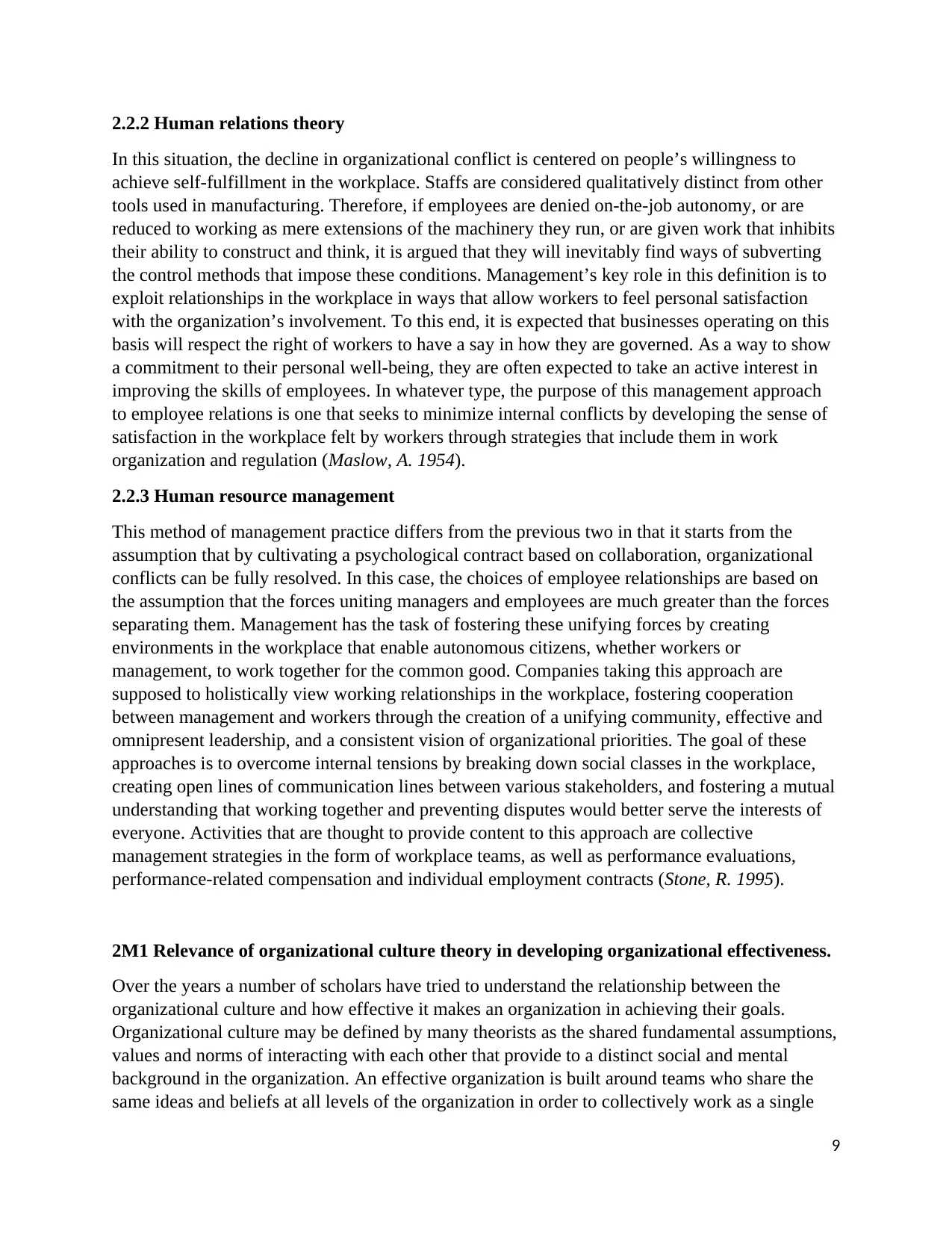
2.2.2 Human relations theory
In this situation, the decline in organizational conflict is centered on people’s willingness to
achieve self-fulfillment in the workplace. Staffs are considered qualitatively distinct from other
tools used in manufacturing. Therefore, if employees are denied on-the-job autonomy, or are
reduced to working as mere extensions of the machinery they run, or are given work that inhibits
their ability to construct and think, it is argued that they will inevitably find ways of subverting
the control methods that impose these conditions. Management’s key role in this definition is to
exploit relationships in the workplace in ways that allow workers to feel personal satisfaction
with the organization’s involvement. To this end, it is expected that businesses operating on this
basis will respect the right of workers to have a say in how they are governed. As a way to show
a commitment to their personal well-being, they are often expected to take an active interest in
improving the skills of employees. In whatever type, the purpose of this management approach
to employee relations is one that seeks to minimize internal conflicts by developing the sense of
satisfaction in the workplace felt by workers through strategies that include them in work
organization and regulation (Maslow, A. 1954).
2.2.3 Human resource management
This method of management practice differs from the previous two in that it starts from the
assumption that by cultivating a psychological contract based on collaboration, organizational
conflicts can be fully resolved. In this case, the choices of employee relationships are based on
the assumption that the forces uniting managers and employees are much greater than the forces
separating them. Management has the task of fostering these unifying forces by creating
environments in the workplace that enable autonomous citizens, whether workers or
management, to work together for the common good. Companies taking this approach are
supposed to holistically view working relationships in the workplace, fostering cooperation
between management and workers through the creation of a unifying community, effective and
omnipresent leadership, and a consistent vision of organizational priorities. The goal of these
approaches is to overcome internal tensions by breaking down social classes in the workplace,
creating open lines of communication lines between various stakeholders, and fostering a mutual
understanding that working together and preventing disputes would better serve the interests of
everyone. Activities that are thought to provide content to this approach are collective
management strategies in the form of workplace teams, as well as performance evaluations,
performance-related compensation and individual employment contracts (Stone, R. 1995).
2M1 Relevance of organizational culture theory in developing organizational effectiveness.
Over the years a number of scholars have tried to understand the relationship between the
organizational culture and how effective it makes an organization in achieving their goals.
Organizational culture may be defined by many theorists as the shared fundamental assumptions,
values and norms of interacting with each other that provide to a distinct social and mental
background in the organization. An effective organization is built around teams who share the
same ideas and beliefs at all levels of the organization in order to collectively work as a single
9
In this situation, the decline in organizational conflict is centered on people’s willingness to
achieve self-fulfillment in the workplace. Staffs are considered qualitatively distinct from other
tools used in manufacturing. Therefore, if employees are denied on-the-job autonomy, or are
reduced to working as mere extensions of the machinery they run, or are given work that inhibits
their ability to construct and think, it is argued that they will inevitably find ways of subverting
the control methods that impose these conditions. Management’s key role in this definition is to
exploit relationships in the workplace in ways that allow workers to feel personal satisfaction
with the organization’s involvement. To this end, it is expected that businesses operating on this
basis will respect the right of workers to have a say in how they are governed. As a way to show
a commitment to their personal well-being, they are often expected to take an active interest in
improving the skills of employees. In whatever type, the purpose of this management approach
to employee relations is one that seeks to minimize internal conflicts by developing the sense of
satisfaction in the workplace felt by workers through strategies that include them in work
organization and regulation (Maslow, A. 1954).
2.2.3 Human resource management
This method of management practice differs from the previous two in that it starts from the
assumption that by cultivating a psychological contract based on collaboration, organizational
conflicts can be fully resolved. In this case, the choices of employee relationships are based on
the assumption that the forces uniting managers and employees are much greater than the forces
separating them. Management has the task of fostering these unifying forces by creating
environments in the workplace that enable autonomous citizens, whether workers or
management, to work together for the common good. Companies taking this approach are
supposed to holistically view working relationships in the workplace, fostering cooperation
between management and workers through the creation of a unifying community, effective and
omnipresent leadership, and a consistent vision of organizational priorities. The goal of these
approaches is to overcome internal tensions by breaking down social classes in the workplace,
creating open lines of communication lines between various stakeholders, and fostering a mutual
understanding that working together and preventing disputes would better serve the interests of
everyone. Activities that are thought to provide content to this approach are collective
management strategies in the form of workplace teams, as well as performance evaluations,
performance-related compensation and individual employment contracts (Stone, R. 1995).
2M1 Relevance of organizational culture theory in developing organizational effectiveness.
Over the years a number of scholars have tried to understand the relationship between the
organizational culture and how effective it makes an organization in achieving their goals.
Organizational culture may be defined by many theorists as the shared fundamental assumptions,
values and norms of interacting with each other that provide to a distinct social and mental
background in the organization. An effective organization is built around teams who share the
same ideas and beliefs at all levels of the organization in order to collectively work as a single
9
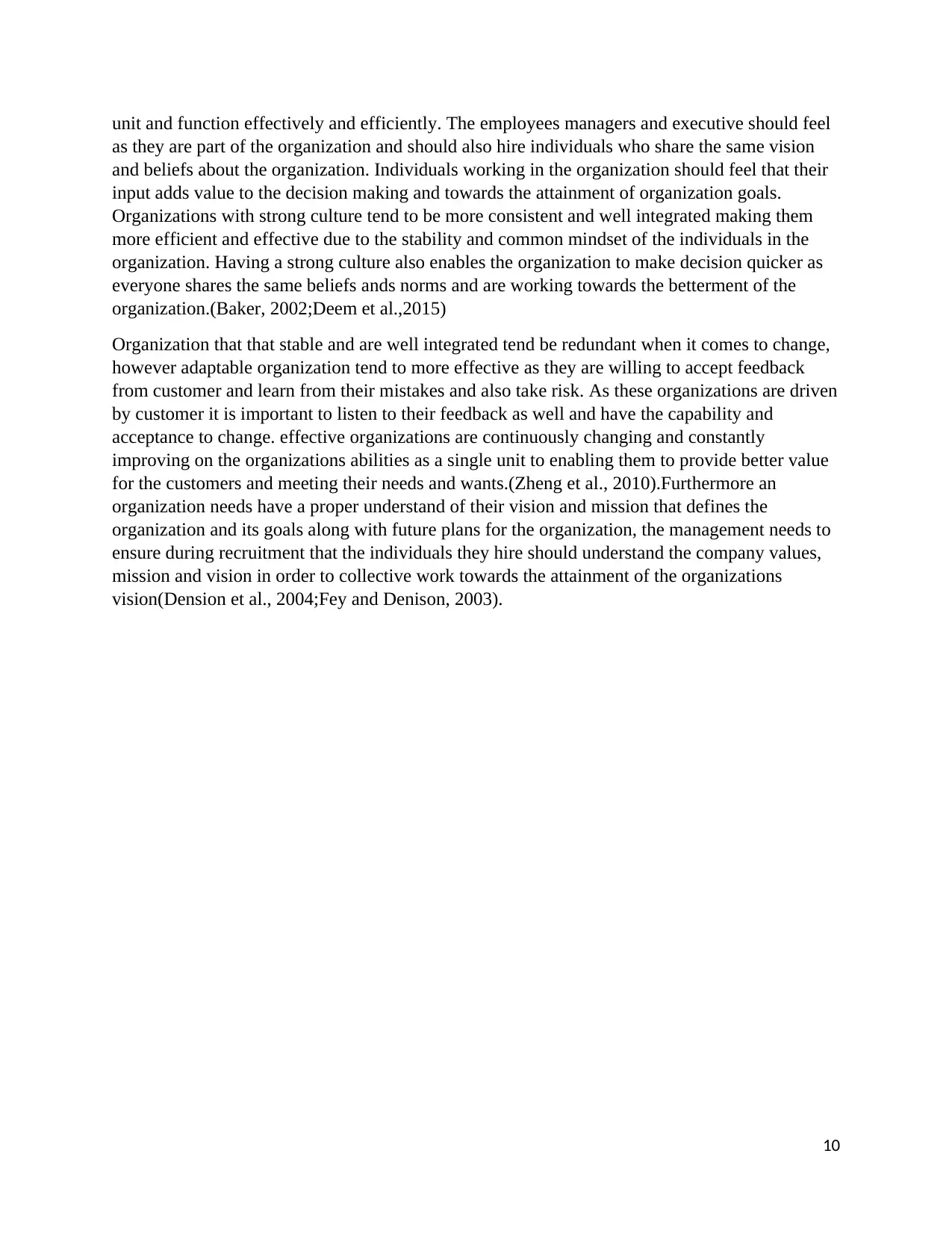
unit and function effectively and efficiently. The employees managers and executive should feel
as they are part of the organization and should also hire individuals who share the same vision
and beliefs about the organization. Individuals working in the organization should feel that their
input adds value to the decision making and towards the attainment of organization goals.
Organizations with strong culture tend to be more consistent and well integrated making them
more efficient and effective due to the stability and common mindset of the individuals in the
organization. Having a strong culture also enables the organization to make decision quicker as
everyone shares the same beliefs ands norms and are working towards the betterment of the
organization.(Baker, 2002;Deem et al.,2015)
Organization that that stable and are well integrated tend be redundant when it comes to change,
however adaptable organization tend to more effective as they are willing to accept feedback
from customer and learn from their mistakes and also take risk. As these organizations are driven
by customer it is important to listen to their feedback as well and have the capability and
acceptance to change. effective organizations are continuously changing and constantly
improving on the organizations abilities as a single unit to enabling them to provide better value
for the customers and meeting their needs and wants.(Zheng et al., 2010).Furthermore an
organization needs have a proper understand of their vision and mission that defines the
organization and its goals along with future plans for the organization, the management needs to
ensure during recruitment that the individuals they hire should understand the company values,
mission and vision in order to collective work towards the attainment of the organizations
vision(Dension et al., 2004;Fey and Denison, 2003).
10
as they are part of the organization and should also hire individuals who share the same vision
and beliefs about the organization. Individuals working in the organization should feel that their
input adds value to the decision making and towards the attainment of organization goals.
Organizations with strong culture tend to be more consistent and well integrated making them
more efficient and effective due to the stability and common mindset of the individuals in the
organization. Having a strong culture also enables the organization to make decision quicker as
everyone shares the same beliefs ands norms and are working towards the betterment of the
organization.(Baker, 2002;Deem et al.,2015)
Organization that that stable and are well integrated tend be redundant when it comes to change,
however adaptable organization tend to more effective as they are willing to accept feedback
from customer and learn from their mistakes and also take risk. As these organizations are driven
by customer it is important to listen to their feedback as well and have the capability and
acceptance to change. effective organizations are continuously changing and constantly
improving on the organizations abilities as a single unit to enabling them to provide better value
for the customers and meeting their needs and wants.(Zheng et al., 2010).Furthermore an
organization needs have a proper understand of their vision and mission that defines the
organization and its goals along with future plans for the organization, the management needs to
ensure during recruitment that the individuals they hire should understand the company values,
mission and vision in order to collective work towards the attainment of the organizations
vision(Dension et al., 2004;Fey and Denison, 2003).
10
Secure Best Marks with AI Grader
Need help grading? Try our AI Grader for instant feedback on your assignments.
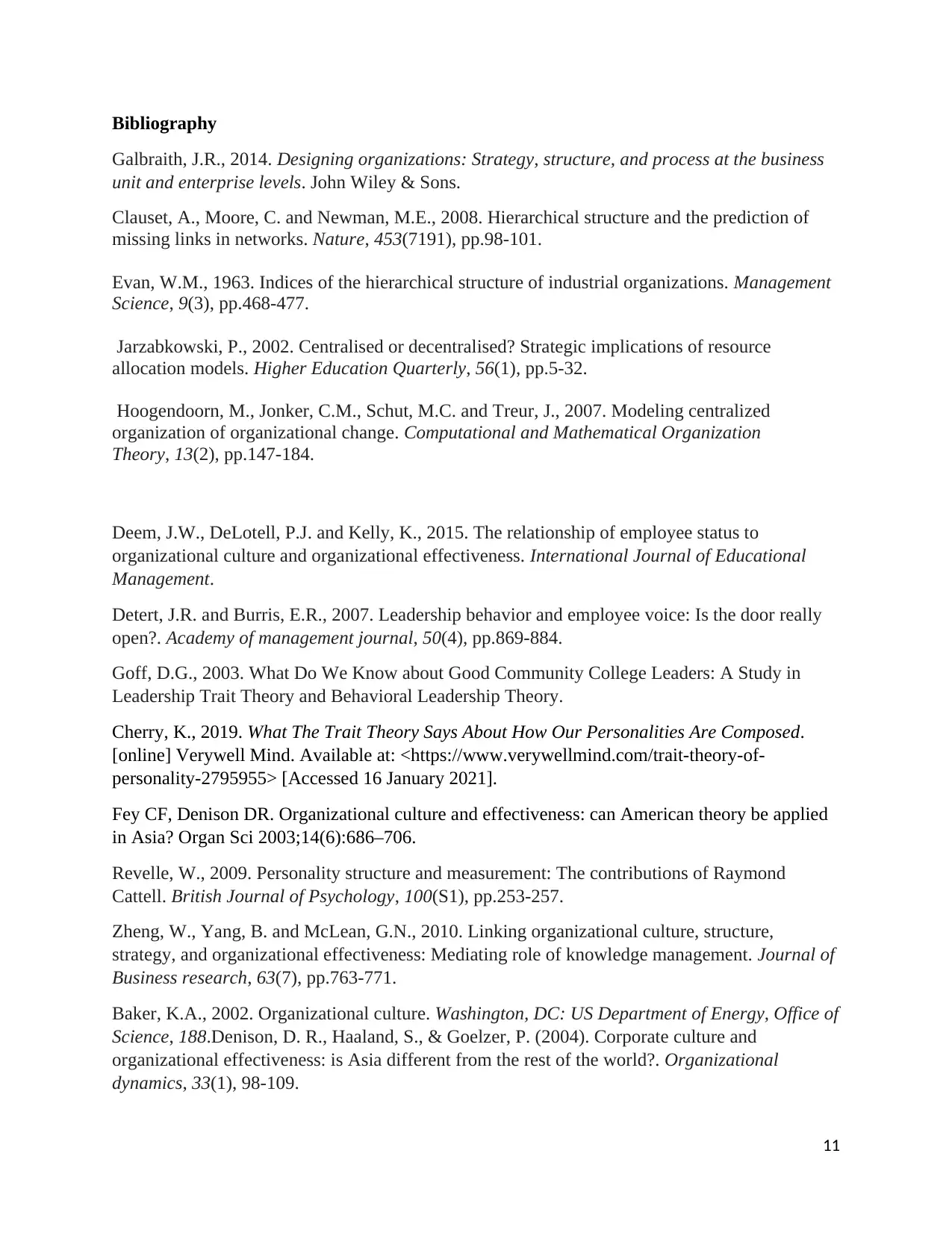
Bibliography
Galbraith, J.R., 2014. Designing organizations: Strategy, structure, and process at the business
unit and enterprise levels. John Wiley & Sons.
Clauset, A., Moore, C. and Newman, M.E., 2008. Hierarchical structure and the prediction of
missing links in networks. Nature, 453(7191), pp.98-101.
Evan, W.M., 1963. Indices of the hierarchical structure of industrial organizations. Management
Science, 9(3), pp.468-477.
Jarzabkowski, P., 2002. Centralised or decentralised? Strategic implications of resource
allocation models. Higher Education Quarterly, 56(1), pp.5-32.
Hoogendoorn, M., Jonker, C.M., Schut, M.C. and Treur, J., 2007. Modeling centralized
organization of organizational change. Computational and Mathematical Organization
Theory, 13(2), pp.147-184.
Deem, J.W., DeLotell, P.J. and Kelly, K., 2015. The relationship of employee status to
organizational culture and organizational effectiveness. International Journal of Educational
Management.
Detert, J.R. and Burris, E.R., 2007. Leadership behavior and employee voice: Is the door really
open?. Academy of management journal, 50(4), pp.869-884.
Goff, D.G., 2003. What Do We Know about Good Community College Leaders: A Study in
Leadership Trait Theory and Behavioral Leadership Theory.
Cherry, K., 2019. What The Trait Theory Says About How Our Personalities Are Composed.
[online] Verywell Mind. Available at: <https://www.verywellmind.com/trait-theory-of-
personality-2795955> [Accessed 16 January 2021].
Fey CF, Denison DR. Organizational culture and effectiveness: can American theory be applied
in Asia? Organ Sci 2003;14(6):686–706.
Revelle, W., 2009. Personality structure and measurement: The contributions of Raymond
Cattell. British Journal of Psychology, 100(S1), pp.253-257.
Zheng, W., Yang, B. and McLean, G.N., 2010. Linking organizational culture, structure,
strategy, and organizational effectiveness: Mediating role of knowledge management. Journal of
Business research, 63(7), pp.763-771.
Baker, K.A., 2002. Organizational culture. Washington, DC: US Department of Energy, Office of
Science, 188.Denison, D. R., Haaland, S., & Goelzer, P. (2004). Corporate culture and
organizational effectiveness: is Asia different from the rest of the world?. Organizational
dynamics, 33(1), 98-109.
11
Galbraith, J.R., 2014. Designing organizations: Strategy, structure, and process at the business
unit and enterprise levels. John Wiley & Sons.
Clauset, A., Moore, C. and Newman, M.E., 2008. Hierarchical structure and the prediction of
missing links in networks. Nature, 453(7191), pp.98-101.
Evan, W.M., 1963. Indices of the hierarchical structure of industrial organizations. Management
Science, 9(3), pp.468-477.
Jarzabkowski, P., 2002. Centralised or decentralised? Strategic implications of resource
allocation models. Higher Education Quarterly, 56(1), pp.5-32.
Hoogendoorn, M., Jonker, C.M., Schut, M.C. and Treur, J., 2007. Modeling centralized
organization of organizational change. Computational and Mathematical Organization
Theory, 13(2), pp.147-184.
Deem, J.W., DeLotell, P.J. and Kelly, K., 2015. The relationship of employee status to
organizational culture and organizational effectiveness. International Journal of Educational
Management.
Detert, J.R. and Burris, E.R., 2007. Leadership behavior and employee voice: Is the door really
open?. Academy of management journal, 50(4), pp.869-884.
Goff, D.G., 2003. What Do We Know about Good Community College Leaders: A Study in
Leadership Trait Theory and Behavioral Leadership Theory.
Cherry, K., 2019. What The Trait Theory Says About How Our Personalities Are Composed.
[online] Verywell Mind. Available at: <https://www.verywellmind.com/trait-theory-of-
personality-2795955> [Accessed 16 January 2021].
Fey CF, Denison DR. Organizational culture and effectiveness: can American theory be applied
in Asia? Organ Sci 2003;14(6):686–706.
Revelle, W., 2009. Personality structure and measurement: The contributions of Raymond
Cattell. British Journal of Psychology, 100(S1), pp.253-257.
Zheng, W., Yang, B. and McLean, G.N., 2010. Linking organizational culture, structure,
strategy, and organizational effectiveness: Mediating role of knowledge management. Journal of
Business research, 63(7), pp.763-771.
Baker, K.A., 2002. Organizational culture. Washington, DC: US Department of Energy, Office of
Science, 188.Denison, D. R., Haaland, S., & Goelzer, P. (2004). Corporate culture and
organizational effectiveness: is Asia different from the rest of the world?. Organizational
dynamics, 33(1), 98-109.
11
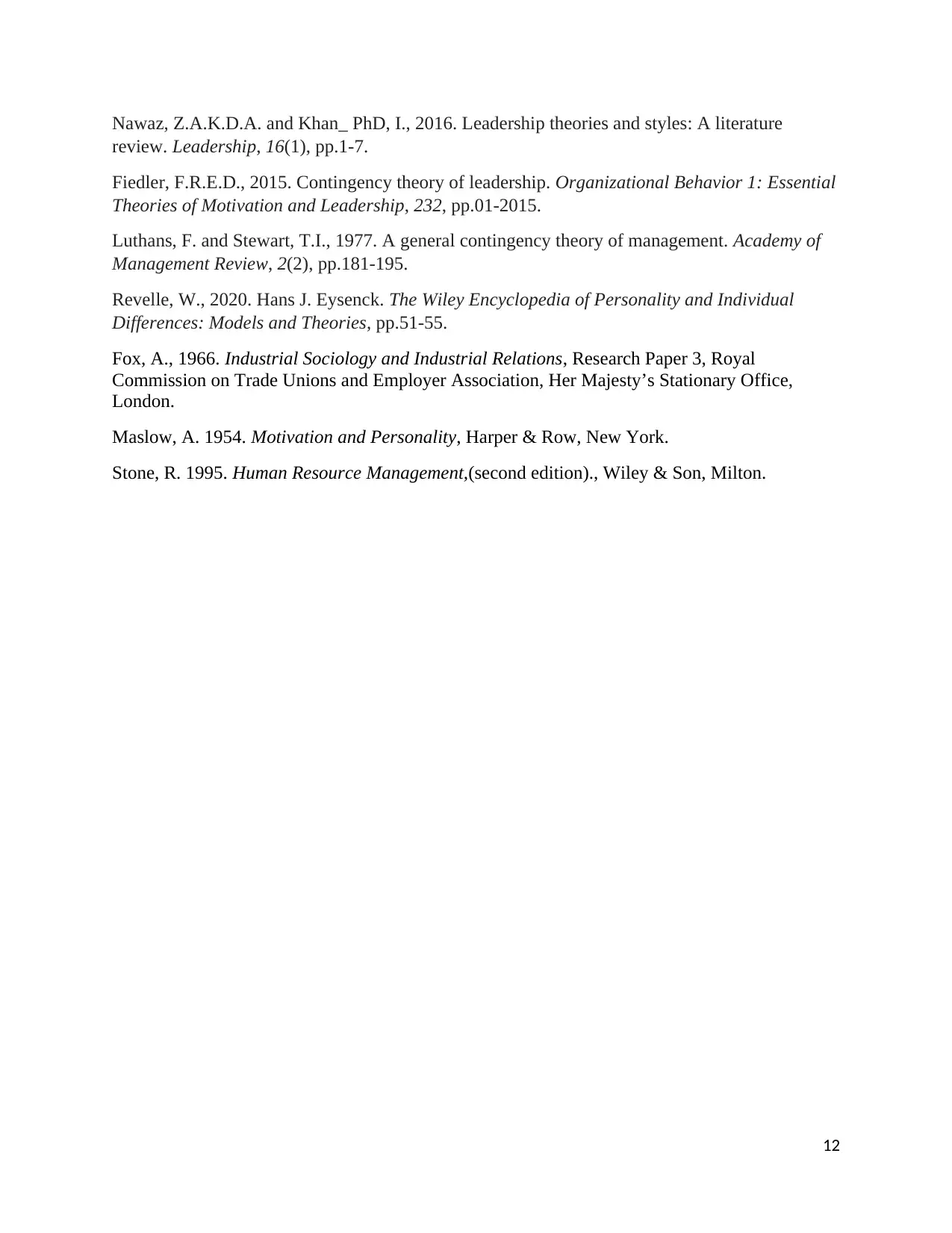
Nawaz, Z.A.K.D.A. and Khan_ PhD, I., 2016. Leadership theories and styles: A literature
review. Leadership, 16(1), pp.1-7.
Fiedler, F.R.E.D., 2015. Contingency theory of leadership. Organizational Behavior 1: Essential
Theories of Motivation and Leadership, 232, pp.01-2015.
Luthans, F. and Stewart, T.I., 1977. A general contingency theory of management. Academy of
Management Review, 2(2), pp.181-195.
Revelle, W., 2020. Hans J. Eysenck. The Wiley Encyclopedia of Personality and Individual
Differences: Models and Theories, pp.51-55.
Fox, A., 1966. Industrial Sociology and Industrial Relations, Research Paper 3, Royal
Commission on Trade Unions and Employer Association, Her Majesty’s Stationary Office,
London.
Maslow, A. 1954. Motivation and Personality, Harper & Row, New York.
Stone, R. 1995. Human Resource Management,(second edition)., Wiley & Son, Milton.
12
review. Leadership, 16(1), pp.1-7.
Fiedler, F.R.E.D., 2015. Contingency theory of leadership. Organizational Behavior 1: Essential
Theories of Motivation and Leadership, 232, pp.01-2015.
Luthans, F. and Stewart, T.I., 1977. A general contingency theory of management. Academy of
Management Review, 2(2), pp.181-195.
Revelle, W., 2020. Hans J. Eysenck. The Wiley Encyclopedia of Personality and Individual
Differences: Models and Theories, pp.51-55.
Fox, A., 1966. Industrial Sociology and Industrial Relations, Research Paper 3, Royal
Commission on Trade Unions and Employer Association, Her Majesty’s Stationary Office,
London.
Maslow, A. 1954. Motivation and Personality, Harper & Row, New York.
Stone, R. 1995. Human Resource Management,(second edition)., Wiley & Son, Milton.
12
1 out of 12
Related Documents
Your All-in-One AI-Powered Toolkit for Academic Success.
+13062052269
info@desklib.com
Available 24*7 on WhatsApp / Email
![[object Object]](/_next/static/media/star-bottom.7253800d.svg)
Unlock your academic potential
© 2024 | Zucol Services PVT LTD | All rights reserved.




